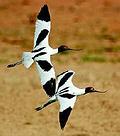 澳洲鳥會最近發表一份進行5年的調查報告,發現多數澳洲鳥類特有種受到棲地流失、乾旱、和入侵種的影響,數量正在減少。
澳洲鳥會最近發表一份進行5年的調查報告,發現多數澳洲鳥類特有種受到棲地流失、乾旱、和入侵種的影響,數量正在減少。
環境部長葛瑞(Peter Garrett)2月26日在國會山莊發表該報告時表示:「《2008年澳洲鳥類狀況》清楚地陳述了我們野生動物發生了什麼狀況。」「知識是做好保育的基礎,報告中的知識非常重要,當我們試圖在做好保育、保留、還有任何可能的地方去改進。」
澳洲鳥類中心總理哈蜜頓博士(Graeme Hamilton)說:「雖然這份報告是針對鳥類,但內容卻能對自然與社會提供更廣泛的應用。鳥類是國家生活品質的指標。生物多樣性的流失是很嚴重的問題,因為他反應了其他物種的流失,例如哺乳類、爬蟲類、植物。」
哈蜜頓說,澳洲鳥類中心是國內歷史最悠久、且最受尊崇的國家鳥類保育機構,他們希望與各州、 英聯邦成員國政府一起反轉鳥類生物多樣性的流失。
這是第六階段對澳洲鳥類的報告,並呈現最新的鳥類族群健康綜合狀況,以及提出面臨的永續性問題。這項 2008 年的報告專注在鳥類族群數量的變化,則是來自 50 個已進展 40 年的長期監督計畫結果。
這個報告呈現出鳥類族群變化趨勢不一致。與 2003 年報告相比,如今更多物種還在持續減少。當初很常見的鳥類現在再也不常見了,像澳洲原本十分常見的黑背鍾鵲(Gymnorhina tibicen),今數量銳減。 尤其在莫瑞達令盆地(Murray-Darling basin)上, 受到乾旱以及水經營措施不足而乾涸,水鳥族群數量亦銳減。 (相關資料點此參考。)
 「沿岸的候鳥與留鳥數量也在近幾年來顯著的下降,只有居住在草叢的鳥類比較好一點。」哈蜜頓說。「那些以採集林地底層或地面上的昆蟲維生的鳥類,如:知更鳥、犀鳥、扇尾鶲、旋木雀等林鳥, 由於棲地清潔與其他修整工作的進行,在澳洲東南部的數量都減少了。」
「沿岸的候鳥與留鳥數量也在近幾年來顯著的下降,只有居住在草叢的鳥類比較好一點。」哈蜜頓說。「那些以採集林地底層或地面上的昆蟲維生的鳥類,如:知更鳥、犀鳥、扇尾鶲、旋木雀等林鳥, 由於棲地清潔與其他修整工作的進行,在澳洲東南部的數量都減少了。」
但這項報告也凸顯出部份受威脅的物種數量已經增加,例如白腹穴鳥、黑鳳頭鸚鵡、以及超級鸚鵡等,在食物攝取上都有改善。「振奮人心的是那些受到積極地復育計畫管理的物種正在大量增加。」葛瑞繼續說。
然而,澳洲聯邦法庭 2008 年 5 月曾限制伐木,因為伐木會驅使塔思馬尼亞楔尾鵰與虎皮鸚鵡瀕臨滅絕;但隨後又在聽證會上表示伐木可以進行。
長期抵抗塔思馬尼亞的林地地面伐木工程的澳洲綠黨領袖,也是現任參議員布朗(Bob Brown) ,在法庭與議會上同意澳洲鳥類中心的說法,認為在瀕危鳥類居住的老熟林中進行伐木作業是 『 國恥 』。
從英國劍橋國際鳥盟科學部長史塔特菲爾(Alison Stattersfield)說澳洲鳥類中心做了一項令人印象深刻的報告,他們分析鳥類族群變化趨勢的最新消息。他們的發現正與國際鳥盟在去年發表的世界鳥類報告不謀而合。
「世界上現在正針對鳥類族群與棲地變動,所進行長期的監測研究中,都發現越來越多證據指出更多族群減少,而只有少數族群增加。我們觀察的努力需要更龐大的準備以阻止生物多樣性的流失。」史塔特菲爾說。
欲瀏覽《2008年澳洲鳥類現況報告》,請點選連結。
A five-year report card on the state of Australia's birds by Birds Australia shows many of the continent's unique native species are in decline due to habitat loss, drought and introduced predators.
Environment Minister Peter Garrett launched the report at Parliament House today, saying, "The State of Australia's Birds 2008 spells out clearly what is going on with our birdlife."
"Knowledge is the foundation of good conservation and the knowledge contained in this report is immensely important as we strive to protect, conserve, and where possible, improve our environment," Garrett said.
Dr. Graeme Hamilton, Birds Australia chief executive, said, "Although the report deals with birds, the findings have much broader implications for nature and society. Birds are indicators of national quality of life. This loss of bird biodiversity is serious as it will also reflect the loss in other groups such as mammals, reptiles, and plants."
Hamilton says Birds Australia, the country's oldest and most respected national bird conservation organization, wants to work with state and commonwealth governments to reverse the trend in losses in bird biodiversity.
This is the sixth state of Australia's birds' report, and presents an up-to-date overview of the health of bird populations in Australia and the main challenges to their sustainability.
This 2008 report focuses on trends in bird populations revealed by some 50 long-term monitoring programs that have been running for up to 40 years.
The report shows that trends in bird populations are mixed, but more species are in decline than were reported in 2003. Common birds are far less common than they once were. For example, populations of the familiar Australian magpie, Gymnorhina tibicen, have slumped.
Water birds are in steep decline, particularly in the parched Murray-Darling basin due to drought and poor water management practices, the report shows.
"Numbers of migratory and resident shorebirds have fallen dramatically in recent years," Hamilton said. "Birds in the bush are faring little better."
"Woodland birds, such as robins, thornbills, fantails and treecreepers, which feed on insects on or near the ground, have all declined in south-eastern Australia due to habitat clearance and other modification," he said.
The report also shows some success where a number of threatened species have increased in population. Birds such as Gould's petrel, glossy black-cockatoo and superb parrot are all faring better than they have in the past.
Found only in Australia, the Tasmanian wedge-tailed eagle, Aquila audax fleayi, is federally listed as Critically Endangered. (Photo courtesy Wildlife Tasmania)
"What's heartening is the proof that where species have been actively managed with recovery plans we are seeing a great result," Garrett said.
But in May 2008 the Australian Federal Court ruled that the logging will drive Tasmania's giant wedge-tailed eagle and swift parrot towards extinction - then on appeal said the logging could go ahead.
Australian Greens leader Senator Bob Brown, who has battled logging in Tasmania on the ground, in court and in Parliament, observed that the Birds Australia report calls old-growth logging in Tasmania "a national disgrace" because endangered bird species lived there.
From Cambridge, England, Alison Stattersfield, BirdLife International's head of science, said, "Birds Australia have done an impressive job of analyzing the latest information on trends in bird populations. Their findings are extremely concerning and mirror those presented in BirdLife International's 'State of the world's birds' report published last year."
"Globally, there is increasing evidence from long-term monitoring studies of major changes in bird communities and their habitats, with many species declining and few increasing," Stattersfield said. "Our conservation efforts need to be geared up tremendously to halt this loss of biodiversity."





